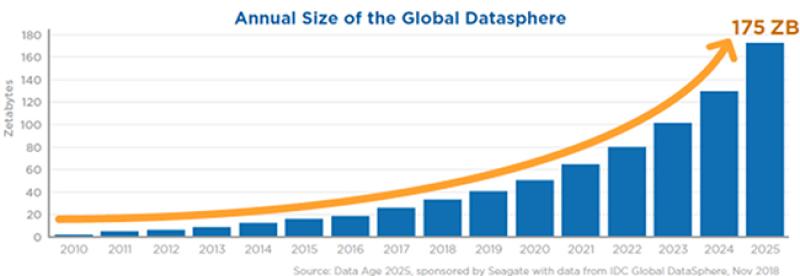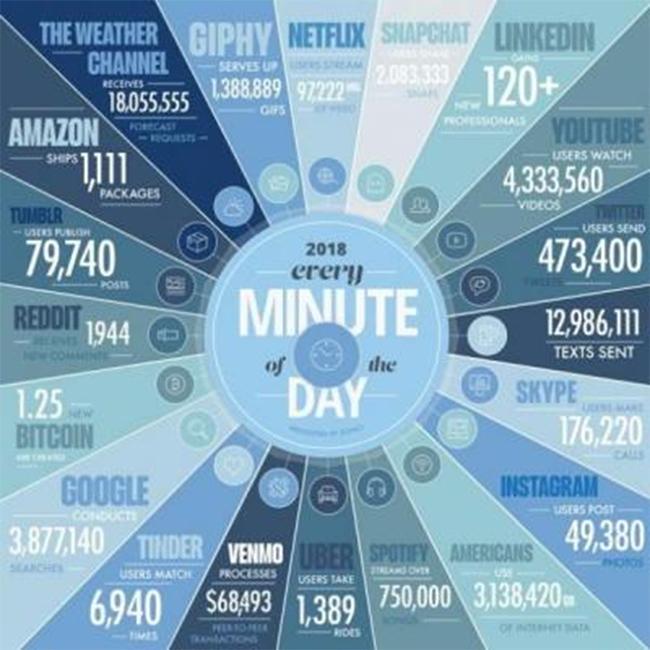The truth about our digital footprint - and how to reduce it
Digital technology and the Internet in particular are often associated with a new, greener economy. Indeed, reducing paper consumption, using video conferences instead of flying to meetings, and introducing smart grids to save energy are but a few examples of how digitalisation can help us protect the environment.
However, the emergence of a hyper-connected way of life has caused the digital sector itself to become a major energy consumer and producer of greenhouse gases (GHG). As with most other aspects of modern day life, overconsumption is causing the planet to overheat, and technology cannot be a ‘cure-all’ solution if we don’t change certain behaviours.
A few figures to set the scene:
- The digital sector's energy consumption (related to the production and usage of devices, and to data traffic and storage) is growing by 9% per year and is expected to represent 3.3% of the world’s economic electricity consumption in 2020 (vs. 1.9% in 2013).
- The digital sector was already responsible for 3.3% of global GHG emissions in 2017, well above civil aviation (2%), often seen as one of the biggest GHG emitters. In 2020, its share is expected to reach 4%. This is as much as that of entire India in 2015!
Surprising? Turns out ‘dematerialisation’ is not completely true. The digital economy actually uses quite a bit of material – specifically ample volumes of energy and commodities – to fuel it.
Hardware
Let’s start with hardware, where the ‘material’ aspect is easier to picture (production makes up 45% of the total energy consumption of the digital sector).
We have become addicted to high-tech appliances, from smartphones to tablets, laptops and connected TVs. 7 billion smartphones have been produced since Steve Jobs released his first iPhone. To keep up with the latest, lightest and fastest devices, we (in the richest parts of the world) have been buying a new smartphone every 2 years, on average!
The production phase of a smartphone represents 90% of the direct energy consumption of a smartphone throughout its entire lifecycle, so the more often we get a new one, the more costly to the environment it is.
Electronic devices are made up of thousands of components, rare metals and rare earth elements (40 on average for a smartphone), which are extracted and refined using energy- and water-intensive processes. As mines are often located in countries where environmental and social standards are very low, our race to connectivity, on top of increasing GHG emissions, often translates into deforestation and contamination of land and water (not to mention human rights violations). Recycling solutions are, for the moment, limited and are themselves energy intensive, due to the high number of different metals and low concentration rates.
To make it worse, the production and reserves of these metals are limited, and to secure supply, the digital sector is in direct competition with renewable energies, since the production of windfarms, solar panels and batteries requires some of the same scarce resources.
It is therefore key to extend the life of our devices and fight against planned obsolescence.
Data traffic and storage
Now let’s jump to the even more surprising side of our digital footprint, which is less tangible to users: data traffic and storage.
Already in 2013, Google’s executive chairman Eric Schmidt claimed that “every 2 days, we create as much information as we did up to 2003”. While this is difficult to verify, it gives a taste of the excesses of the ‘Big Data’ era. Data has been growing exponentially, due to the progression of connectivity in the emerging world, and to hyper-connectivity in more developed countries, including the Internet of Things.

Let’s take stock of some of the most basic functionalities of our ‘connected living’:
Email. Any guess of how many emails are exchanged every hour? 10 billion. Only 20% of them are actually read. These emails travel an average of 15,000 km at the speed of light, passing through several servers before reaching their final destination. Just like marathon runners running on slow sugar, emails need energy to complete the race! It is estimated that every single email emits at least 4g of CO2. If an attachment is added, this can go up to 50g, which is equivalent to leaving a low consumption lightbulb switched on for one hour. In total, global email traffic is fuelled by the equivalent of 15 nuclear plants!
Videos. Yet, emails are nothing compared to our addiction to videos, which now represents more than 60% of data traffic, and account for 80% of its growth! Watching a 10 minute video online is the equivalent of sending emails, non-stop, for 5 hours - so I let you do the math.
Data centres. Now, what happens to these video files and emails? They join ‘the Cloud’. But behind the peaceful image of a white cumulus is a less poetic reality, that of data centres composed of thousands of servers that not only need plenty of energy to run, back up and store your files, but also air conditioning, 24 hours a day.
Data centres represented 19% of the global digital energy consumption as of 2017. However, with the explosion in data traffic (+25% per year), the number of data centres is expanding very quickly and their electricity consumption is skyrocketing.
Of course, data storage providers are increasingly running on renewable energy. However, it is fair to wonder if this is the wisest use of these renewable energies, of which – let’s keep this in mind –there is not yet enough of to allow the world to meet the Paris Agreement targets. Let’s also remember that during their construction phase, even renewable power plants are responsible for significant emissions as well.
More generally, we are witnessing the appropriation by the digital sector of a progressively disproportionate share of electricity, while the proportion of consumption related to useful digital activities is actually declining. And here again, the richest part of the world’s population has a bigger footprint (1 American owns, on average, 10 connected devices and consumes 140 Gigabytes of data per month, vs. 1 device and 2 Gigabytes for an Indian) and therefore a bigger responsibility to change.
So in conclusion, try to remember that every click has a footprint. The cloud is not always green.So let’s try to reduce and reuse, and make sure that digital technology remains what it was intended to be: a tool for a better life, not a way of life.

WHAT YOU CAN DO:
Hardware:
- Extend the life of your devices as much as possible. Think twice before upgrading.
- Switch off your computer when you leave.
- Program your computer to go to sleep mode after a few minutes of inactivity.
- Switch off your Wi-Fi when you’re not at home – your Wi-Fi router consumes as much energy as a small fridge.
Internet surfing:
- Use environmentally friendly search engines such as Ecosia.org or Lilo.org, which run on renewables and compensate their carbon footprint through tree plantations or similar projects.
- To the extent possible, use Favourites or History rather than searches - performing a search can consume as much electricity as boiling 1 liter of water.
- Do ‘limited’ searches: whenever possible: perform your searches within a relevant website (Wikipedia, Editus.lu, Amazon, BBC, etc.) rather than on the entire web.
Email:
- Unsubscribe from commercial distribution lists or newsletters that you don’t need. Apps such as Clean Fox can help you do so more efficiently.
- Clean up your mailbox as frequently as possible.
- Whenever possible, send links rather than attachments.
- Send big attachments through file transfer platforms rather than email.
- Do not use huge distribution lists, only send your emails to whoever needs to see them.
- Whenever possible, call or meet in person!
Videos/pictures:
- Try to limit streaming and online gaming to the extent possible.
- Prefer audio files to videos.
- When streaming, use Wi-Fi rather than 4G and avoid viewing in HD whenever possible (doing so you will consume 4 to 10 times less energy).
- Because rare is precious, only share your best pictures with the rest of the world! Choosing is hard, but try publishing only your very best selfies!
Data traffic and storage:
- Be selective, and clean up the data you choose to store on a regular basis.
- Store big files on external hard drives rather than on the Cloud.
- Have you noticed that all the pictures of your friends’ babies received through WhatsApp get automatically stored on your phone and your Cloud? Delete them, we won’t tell your friends… (you can also deactivate automatic download from WhatsApp by going to settings -> Data and Storage Usage -> Media auto-download).
At work:
- Avoid duplication of files saved in different systems.
- Manage document’s lifecycle: delete them when they are not useful anymore, if not required for audit purposes, for example.
- Avoid asking for the restore of a file or an email that could be retrieved in another way.
Finally:
- If you have teenagers at home who walked from school for climate, but spend hours watching YouTube, playing games online, or sending selfies - have them read this article!
SOURCES – IF YOU WANT TO LEARN MORE:
- Climate Care
- The Shift project - Towards digital sobriety
- Guillaume Pitron: La Guerre des métaux rares: la face cachée des transitions énergétiques et numériques, éditions Les Liens qui Libèrent, 2018.
- Cisco Network Traffic Forecast
- Fondation pour la Nature et l’Homme
- IDC White Paper, sponsored by Seagate, Data Age 2025: The Digitization of the World from Edge to Core, November 2018.
